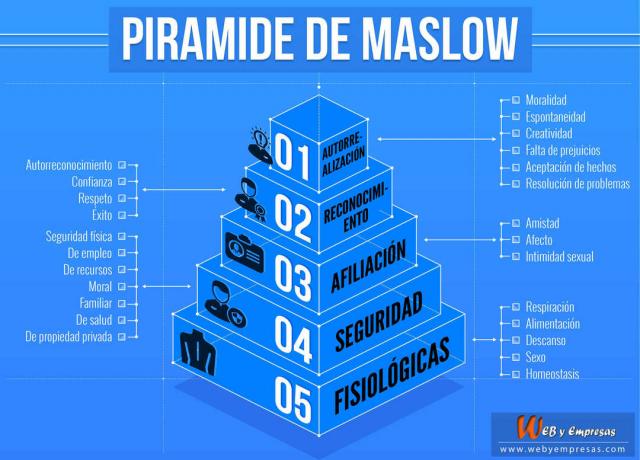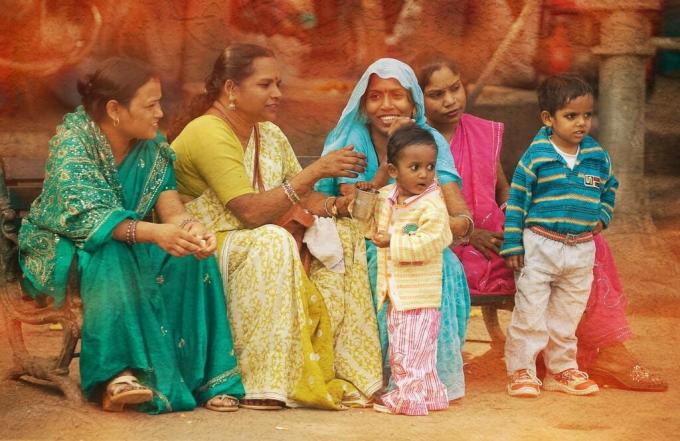Maslow's pyramid or also called Abraham Maslow's "hierarchy of needs" theory is well known and taught in many types of introductory psychology and management classes business. This theory was conceptualized in 1943 in studies on motivation, which describes the circumstances necessary for the psychological well-being of the person. It doesn't matter what your profession is, as you will most likely have to understand this theory at some point in your undergraduate career.

Advertisements
Maslow argued that human needs they could be characterized hierarchically, in a graphic model as a 5-layer pyramid. Each layer represents a type of human need that must be met (starts at the most basic level) before higher needs can be met. The central idea is that when a person satisfies a need he seeks to fulfill the other link in the pyramid and so on.
Described below Maslow's pyramid:
Advertisements
In this article you will find:
Maslow's hierarchy of needs
Abraham Maslow groups needs into five levels as shown in the image below:

Advertisements
Description of the levels of Maslow's Pyramid
Physiological needs
Physiological motivations include the most basic human motivations such as hunger, thirst, sex, and sensory stimulation. Biological reasons are connected to the body's nervous system and are necessary for human survival. A classic example of these needs is when a person is in a war zone and is hungry, the concept of danger tends to be put aside when he is looking for food.
Advertisements
Security needs
The second block in Maslow's hierarchy of needs is the safety. Safety needs can only be met after the most basic physiological needs have been satisfied. It is essential to provide the security needs of people, be it mental and / or emotional security. Within this link are topics such as living in a safe environment, job stability, medical insurance and financial savings.
Membership needs
The third pillar of the Maslow's pyramid are social needs. This block of the pyramid recognizes that human beings are social creatures and need social interaction as well as acceptance from their peers. Since the lower physiological and safety needs have been met, it moves to the next level of more advanced needs, which have to do with social interaction. At this level are friendship, affection, and sexual intimacy.
Advertisements
Needs of recognition
People can anticipate esteem needs, recognizing the work done by others. The need for esteem and, consequently, respect does not always have to do with a monetary reward since a simple acknowledgment in the form of verbal praise is often a satisfying way to satisfy this need. At this level we find needs such as self-recognition, trust, respect and success.
Self-actualization or self-actualization
The fifth and highest level of the Maslow's pyramid it is the need for self-realization. This need can only be satisfied after all other needs in the hierarchy have been sufficiently met. Self-actualization, as described by Maslow, is the person's need to achieve his destiny in life. As a result of this intense need, a person will push himself and herself in a way never before experienced. In this link we find needs such as creativity, morality, lack of prejudice and problem solving.
Criticizes Maslow's pyramid theory
The most important limitation of Maslow's theory concerns his methodology. Maslow formulated the characteristics of self-actualizing individuals with a qualitative method called biographical analysis.
He was studying the biographies and texts of 18 people that he identified as self-actualizing people. From these sources he developed a list of qualities that seemed characteristic of this specific group of people, as opposed to humanity in general.
From a scientific perspective there are numerous problems with this particular approach. First, it could be argued that biographical analysis is a highly subjective method that relies entirely on the opinion of the researcher. Personal opinion is always prone to bias, which reduces the validity of the data obtained. Therefore, Maslow's definition of self-actualization must not be accepted "blindly" as scientific fact.
In addition, the biographical analysis of Maslow focused on a biased sample of self-actualizing, highly educated individuals that basically consisted of white men (such as Thomas Jefferson, Abraham Lincoln, Albert Einstein, William James, Aldous Huxley, Gandhi, Beethoven).
Although Maslow (1970) studied "self-actualizing" female individuals, such as Eleanor Roosevelt and Mother Teresa, who were part of a small proportion of the sample. This makes it difficult to generalize his theory to individuals from lower social classes or different ethnic groups. Thus questioning the validity of Maslow's population of results.
Furthermore, it is extremely difficult to empirically test Maslow's concept of self realisation due to the causal relationships of each person.
Another criticism concerning Maslow's hypothesis is that lower needs must be satisfied before a person can reach his potential and self-realization. This is not always the case, and therefore Maslow's hierarchy of needs has in some respects been falsified.
Through studies of other cultures where large numbers of people live in poverty (such as India) are Of course, people are still capable of meeting higher-order needs such as love and membership. However, this does not happen, according to Maslow's theory, since it states that people who have difficulty reaching very basic physiological needs (such as food, shelter etc.) are not able to satisfy further growth of the needs.

Maslow's Pyramid in Business
The first level of Maslow's hierarchy is needs physiological. In businesses, this can be met by having good office space and equipment to get jobs done. The best business idea will go nowhere if the resources required to make it a reality are not provided. The workplace can be seen as the "body" of the company.
At the individual level, safety it is interpreted as the presence of predictability and protection against harm. The same needs that are present in business. Once the physical plant (workplace) is established, the employer has to be sure that he is not going to be mugged, burned or otherwise harmed. The Safety in business also requires a constant source of income to minimize risks. A company that is operating within a society that has an operating system under the law and a healthy economy has its basic security needs assured.
The idea of membership in business it is less personal and emotional, but it is just as important. A business does not require physical contact to develop this need but needs to maintain good relationships with its suppliers and customers. This type of economic ownership is essential for a company to prosper, because a company in isolation has no one to do business with. Developing healthy, mutually beneficial and sustainable business relationships is a critical step in a successful business.
In business, Maslow's esteem concept can be interpreted as business reputation, customer loyalty, and word-of-mouth advertising. When a company creates a good product at a reasonable price, it treats its customers well and generally behaves As a responsible corporate citizen, you will win the support, admiration and trade of the community local.
By overcoming all the previous levels, according to Maslow, a commercial version of "self-realization" could be reached. This involves, for example, research and development of new and innovative products, or perhaps expansion to other geographic areas. Some companies use their success to do philanthropic work and help people in need. In the final stage of the Maslow Pyramid the successful individual or business may focus less on himself and more on taking a look at the world around him.
Here is a more educational video to understand the concept:
Maslow's Pyramid video
Maslow's pyramid It is never too much in the analysis of any human resources department.


